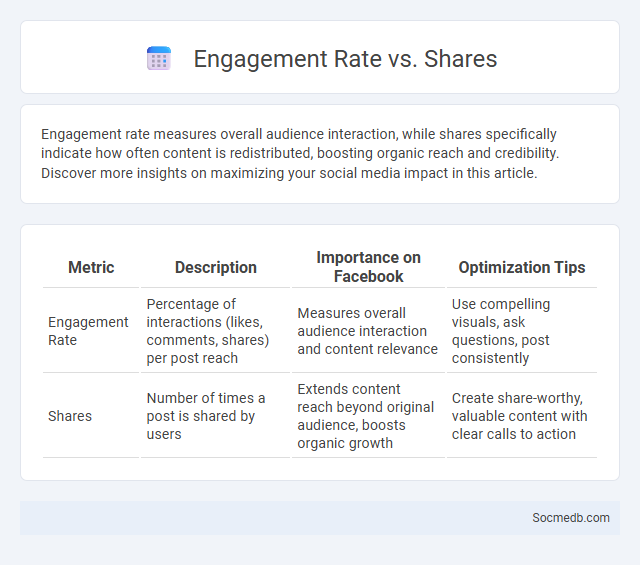
Photo illustration: Engagement Rate vs Shares
Engagement rate measures overall audience interaction, while shares specifically indicate how often content is redistributed, boosting organic reach and credibility. Discover more insights on maximizing your social media impact in this article.
Table of Comparison
| Metric | Description | Importance on Facebook | Optimization Tips |
|---|---|---|---|
| Engagement Rate | Percentage of interactions (likes, comments, shares) per post reach | Measures overall audience interaction and content relevance | Use compelling visuals, ask questions, post consistently |
| Shares | Number of times a post is shared by users | Extends content reach beyond original audience, boosts organic growth | Create share-worthy, valuable content with clear calls to action |
Understanding Engagement Rate: Definition and Importance
Engagement rate measures the level of interaction your content receives relative to your audience size, typically calculated by dividing the total engagements (likes, comments, shares) by the number of followers and multiplying by 100. This key metric reveals the effectiveness of your social media strategy in fostering active participation and building community loyalty. Monitoring engagement rate helps you identify which posts resonate most with your audience, guiding data-driven decisions to optimize content performance.
What Are Shares? An Overview
Shares on social media are user-initiated actions that distribute content from one account to another, increasing its visibility and reach across networks like Facebook, Twitter, and LinkedIn. When you share a post, it generates organic exposure by appearing in your followers' feeds, which can amplify engagement metrics such as likes, comments, and impressions. Understanding shares is crucial for optimizing content strategy and maximizing viral potential within digital marketing campaigns.
Engagement Rate vs Shares: Key Differences
Engagement rate measures the total interactions (likes, comments, shares) relative to followers, offering a comprehensive view of audience involvement, while shares specifically indicate the number of times content is redistributed, reflecting its viral potential. High engagement rate signals overall content appeal, whereas a high share count emphasizes content's ability to reach new audiences beyond immediate followers. Understanding the distinction helps marketers tailor strategies to either boost community interaction or amplify content visibility across platforms.
Calculating Engagement Rate: Metrics and Methods
Calculating engagement rate involves measuring interactions such as likes, comments, shares, and clicks relative to the follower count or reach, providing key insights into content effectiveness. Common methods include dividing total engagements by total followers, or by impressions, then multiplying by 100 to express as a percentage. These metrics help marketers optimize social media strategies by identifying highly engaging content and audience preferences.
The Power of Shares in Social Media Marketing
Shares amplify your brand's reach exponentially by leveraging users' networks to spread content beyond your immediate audience. Social media algorithms prioritize shared content, increasing visibility and engagement rates, which can lead to higher conversion opportunities. Harnessing the power of shares transforms followers into active promoters, driving organic growth and enhancing your marketing ROI.
Factors Influencing Engagement Rate
Engagement rate on social media is primarily influenced by content relevance, posting frequency, and audience targeting. Visual appeal, including high-quality images and videos, significantly boosts interaction levels across platforms like Instagram and Facebook. Timely responses to comments and personalized communication also enhance user engagement and community growth.
Why Shares Matter for Brand Awareness
Shares amplify your brand's reach by exposing your content to a wider, diverse audience beyond your immediate followers. Increased shares boost social proof, signaling credibility and trustworthiness to potential customers. This organic distribution significantly enhances brand awareness and drives engagement, making shares a crucial metric for your social media success.
Engagement Rate vs Shares: Which Metric Matters Most?
Engagement rate measures how actively your audience interacts with your content through likes, comments, and clicks, providing a comprehensive view of user involvement. Shares amplify your content's reach organically by distributing it to new audiences, often leading to higher visibility and potential followers. Understanding which metric matters most depends on your social media goals--whether prioritizing deeper user connection (engagement rate) or expanding audience reach (shares) is key to tailoring your strategy effectively.
Strategies to Boost Engagement Rate and Shares
To boost your social media engagement rate and shares, create compelling, visually appealing content tailored to your target audience's interests and platform behaviors. Utilize interactive features such as polls, quizzes, and live videos to encourage active participation and foster community interaction. Posting consistently at optimal times based on analytics maximizes visibility, while strategic hashtag use broadens reach and encourages user sharing.
Analyzing Trends: Engagement Rate vs Shares Over Time
Analyzing trends in social media engagement reveals a dynamic relationship between engagement rate and shares over time, where spikes in shares often correlate with increased audience interaction and content virality. Tracking these metrics across platforms like Instagram, Twitter, and Facebook provides valuable insights into content performance, audience preferences, and the effectiveness of marketing strategies. Leveraging tools such as social listening and analytics dashboards enables precise measurement of engagement patterns, facilitating optimized content creation to boost brand visibility and audience loyalty.
 socmedb.com
socmedb.com